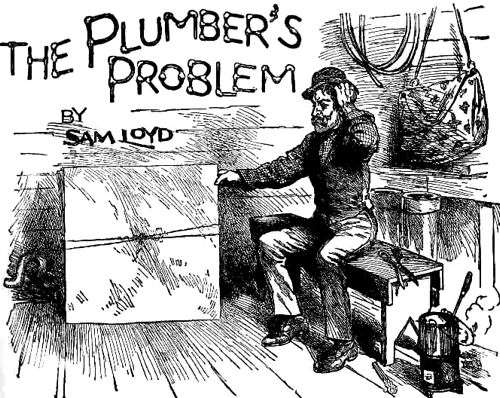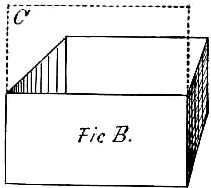



HERE IS A PRACTICAL plumbing lesson which will interest those of a mechanical turn of mind. Plumbers, boilermakers and tank builders estimate in cubic feet, reckoning seven and a half gallons to the cubic foot, which is close enough for all practical purposes. Of course a mathematician would tell us that there are 1,728 cubic in. to a cubic foot, because 12x12x12 = 1,728, while to seven and one-half gallons there are 1,732 1/2, but then plumbers are a liberal set of fellows who cheerfully throw in the extra four and a half inches. A plumber wanted to estimate the lowest possible cost of a copper tank to hold 1,000 cubic feet. Copper comes in sheets three feet square, worth $1.00 per square foot, so the problem is to determine the most economical dimensions of a square tank capable of holding 1,000 cubic feet.
It is self evident that if the bottom of the copper tank is ten feet square, 10 multiplied by 10 gives 100 as the area of the bottom, which multiplied by 10 for the depth, gives the correct dimensions of a tank which will hold 1,000 cubic feet, Mathematically speaking, 10 is here shown to be the cube root of 1,000, and by reversing the proposition we get a clear understanding of what is known as the square and cube of a number. A number multiplied by itself gives its square or 2nd power, like 10 multiplied by 10 equals 100; while if we multiply it once more by the first power, viz. 10 multiplied by 100, we get the cube or third power. The third power is always a perfect cube, but when we multiply it again by 10, which would make 10,000. we have raised the product to the fourth power, and may continue with the fifth, sixth, seventh, etc.,
A cube ten feet square will hold 1,000 cubic feet it is true, but as that would require 500 feet of copper, (100 on the bottom and each of the four sides) it shows that the real point of our problem is to determine the most economical form of a tank; viz.: to hold 1,000 gallons and use the least possible amount of copper.
It is a simple every-day piece of shop work which any mechanic would tackle in a way satisfactory to himself, but which a mathematician will discover involves “the duplication of the cube” which has baffled the world for countless centuries.
The “unsolved problem of the duplication of a cube” is to give the dimensions of a cube twice as large as another, viz.: If a cube ten feet square contains 1,000 cubic feet, what would be the size of a cube containing 2,000 cubic feet?
In the Plumber’s problem it will be found that a rectangular tank twice as wide as it is deep gives the most economical form. If a cube 12.6 feet square holds 2,000 cubic feet, then half that depth would give the required 1,000 feet.

[Page 83]